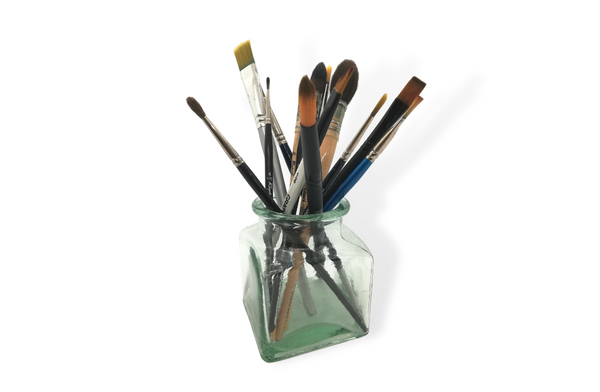
What brushes should I use to paint with gouache and how to clean them?
Share
Gouache is a very versatile, water-soluble medium, just like watercolour and acrylic. Each medium has its own type of brush best suited given its fluidity, to make it easier to apply. As far as paint consistency is concerned, gouache is closer to acrylic than to watercolour.
According to this criterion, the brush for gouache is the same type of brush used for painting with acrylics. Of course, it all depends on the painting style, but in my particular case I feel that the watercolour brush is too soft despite carrying a considerable amount of paint.

So when it comes to buying I choose the brushes that are suitable for acrylics although in occasional cases I use some watercolour ones, small in size.
Watercolour brushes
As for the watercolour brushes, I have experience in using the natural and the synthetic ones and for the type of painting I do I prefer the synthetic ones. Besides being cheaper they are also more long lasting.
The photo below shows several brushes that are more suitable for watercolour and how one of them is used in the application of gouache.

Watercolour brushes that could be used to paint with gouache. I prefer the small sizes to paint because the bigger sizes are too soft. I choose a synthetic brush with bristles that are an imitation of squirrel fur.
Flat brush
Any type of brush is available in different shapes and sizes and stiffness.
The flat brush is extremely useful for painting lower layers and shapes with edges and vertices, taking advantage of the flatness of the bristles. It is very useful for applying thin layers of paint and blending colours by creating seamless transitions.
They can be used for painting with the wide end or with the thin end if we want larger or narrower lines. More or less pressure gives a wider or shorter stroke.

In this image there are some flat brushes and you can see how they paint with gouache, how they are suitable for painting edges by looking at the painted stroke. Also, this brush is quite good for veiling, as you can see in the bottom right corner.
Angle brush
The angle brush can be considered a particular case of the flat brush and can be used as such. However, this cut gives the possibility to trace different and unexpected shapes by applying different pressure on the paper.

Round brush
The round brush is the one you start using in school because it is very versatile and symmetrical to generate the same stroke in any direction for easy handling. It can be used to apply a reasonable amount of paint or to paint narrower and smaller areas due to its pointed tip.
In the image below you can see some strokes of these brushes by applying variations in pressure.

Filbert brush
Finally, the filbert brush is a mix between the flat and the round brush. It is a flat brush and ends in a rounded cut. This cut is extremely useful for painting rounded and organic shapes and also details.

Tips for cleaning brushes
Since gouache is a water-soluble paint, cleaning the brush with gouache is the same as cleaning the brush with watercolour.
- Remove excess paint from the brush using a cloth or absorbent paper.
- Rinse the brush in clean water until no more paint comes out of the brush into the water. Rubbing the brush against the wall of the water container helps remove the paint faster.
- After removing all the paint, put the brush bristles back in their original position using your fingers.
- Leave the brush flat to dry to prevent the water to seep into the ferrule. Once dry you can store it in a jar, upright, with the bristles facing up to avoid bending them.
If you have trouble removing the paint residue from the brush, it might help to rinse the brush in liquid soap on the palm of your hand, rubbing until it comes off and then rinsing under running water to discard all the soap. This procedure is best for removing acrylic and is not usually necessary for gouache unless you are using acrylic gouache and in this case I strongly suggest you make this step.
I hope this post has helped clear up some doubts and made the experience with gouache easier. The most important thing is that you find the material that best suits your painting style and have fun in the process.
For some tips on what kind of paper to use when painting with gouache, see the post "What paper should I use for painting with gouache?"
If you have any doubt or question, write in the comments, I would be very happy to help you on that.
Andreia Melo
